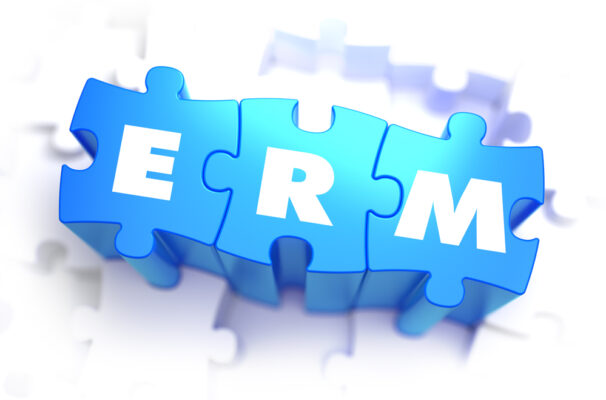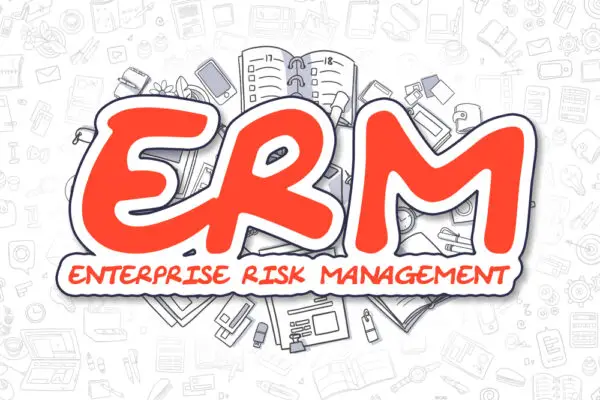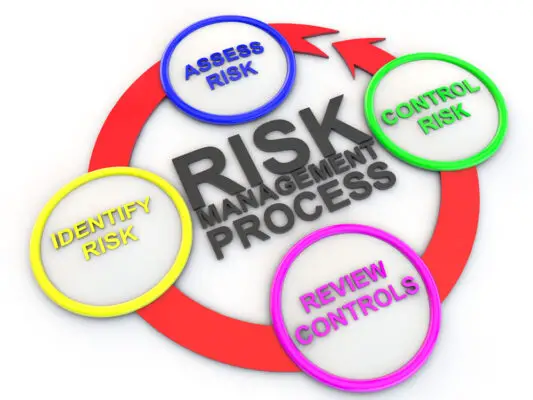Enterprise Risk Management (ERM) is a framework used by organizations to identify and address potential issues that could affect their operations. It can be used to protect the enterprise from harm, create opportunities for improvement, and enable business continuity.
ERM is composed of several components, including risk identification, risk assessment, risk mitigation, and risk monitoring and reporting. Each of these components helps organizations to understand and manage the risks they face.
Additionally, ERM solutions can take many forms, depending on the type of risk and the organization’s needs. This article will analyze the components, types of risks, benefits, limitations, and implementation of ERM, as well as its essential role in modern business.

Overview
Establishing an effective risk management framework is vital for businesses to remain competitive and secure in the current environment.
Enterprise Risk Management (ERM) is an approach to understanding and managing the risks associated with an organization’s operations. ERM seeks to identify potential risks and formulate strategies to mitigate them.
ERM frameworks typically include internal environment, objective setting, risk identification, risk assessment, risk response, control activities, information communication, and monitoring as core components.
ERM can help organizations identify potential risks, develop strategies to manage them, and take proactive steps to reduce potential losses.
Enterprise Risk Management
ERM is a holistic approach to organizational risk management that examines the entire organization’s internal and external environment. It is designed to identify, assess, and prepare for potential losses that can interfere with an organization’s operations and objectives.
ERM takes a top-down approach to risk management, mandating certain business segments engage with or disengage from particular activities. ERM practitioners must take into account the risks associated with each action, and strategize to reduce them.
ERM best practices and standards have been formalized through organizations such as COSO, which helps companies and ERM professionals understand the fundamentals of ERM.ERM is an important tool for businesses of all sizes and in all industries.
ERM solutions protect the enterprise from harm and create opportunities to improve business performance. Companies have no choice but to plan for the unexpected, and need agile, flexible, data-driven ERM.
Robust data analytics, AI, and machine learning can help create scenarios and models that pinpoint not only the potential for harm but the potential for business growth.
Ultimately, ERM ensures that organizations are prepared to respond quickly to unexpected risks and opportunities.
Core Components
Developing an effective enterprise risk management system requires implementation of eight core components as higlighted by COSO ERM 2017, such as internal environment, objective setting, event identification, risk assessment, risk response, control activities, information communication, and monitoring.
The internal environment component of ERM refers to the quality of a firm’s internal control environment, which includes the organization’s ethical values, integrity, and commitment to competence.
The objective setting component involves identifying goals and objectives, which helps inform the risk assessment and risk response components.
The event identification component seeks to identify risks and potential risks that may affect the achievement of the firm’s objectives.
Risk assessment involves assessing the likelihood and impact of the risks identified.
Risk response is the process of selecting and implementing measures to modify the risk identified in the assessment.
Control activities seek to ensure the risk response is properly implemented.
Information communication involves ensuring that relevant information is made available to those responsible for managing risk.
Finally, monitoring reviews the risk management system and assesses its effectiveness.
ERM enables companies to identify and assess risks, understand the impact of those risks, and develop strategies to reduce the negative implications of those risks.
Through creation of an internal environment that fosters ethics and integrity, setting objectives to inform risk assessment and response, identifying potential risks, assessing the likelihood and impact of those risks, implementing strategies to reduce those risks, and monitoring the effectiveness of the system, firms can ensure they have a comprehensive and effective approach to risk management.
Through these components, ERM can help companies achieve their objectives and mitigate potential losses.
By effectively implementing an enterprise risk management system, businesses can ensure they are properly managing risk and safeguarding their operations.
ERM can help increase the likelihood of success and ensure the business is resilient, agile, and prepared for the unexpected.
Types of Risks
Creating a comprehensive risk management plan requires an understanding of the various types of risks that can threaten a business, such as compliance, legal, strategic, operational, security, and financial.
Compliance risk is when a company faces potential violation of external law or requirement. Legal risk is when a company may face lawsuit or penalty for contractual, dispute, or regulatory issues.
Strategic risk is when an organization’s long-term plan may be threatened. Operational risk is when the day-to-day activities of a company may be at risk.
Security risk is when a company’s physical or digital assets may be misappropriated. Finally, financial risk is when a company’s debt or financial standing may be compromised.
ERM helps organizations identify, assess, and prepare for potential losses or harm that can interfere with operations. To address these risks, the company can look into various control activities such as risk reduction, risk sharing, and risk acceptance.
Preventative control activities aim to mitigate risk by disallowing certain events from happening, while detective control activities are in place to recognize when a risky action has taken place.
Information systems should capture data useful to management to better understand a company’s risk profile and management of risk. Additionally, a company can turn to an internal committee or an external auditor to review its policies and practices.
ERM helps protect a company from unexpected losses, reduce redundant processes, ensure efficient use of staff, reduce theft, and increase profitability. ERM is limited in identifying future risks that the organization is unaware of, however, and relies heavily on management estimates and inputs which can be time-intensive and require resources of the company to be successful.
As such, feedback from all employees is essential for successful ERM implementation. Ultimately, ERM helps a company better plan for risks and protect its assets and operations.
Benefits and Limitations
The implementation of an ERM framework can offer numerous advantages, such as preventing losses or unexpected negative outcomes, setting the plans in place to strategically approach risk, and garnering employee buy-in.
ERM also helps a company better plan for risks and protect its assets and operations. Additionally, ERM often summaries the risks a company faces into operational, financial, and strategic risks.
However, there are certain limitations to ERM. For instance, ERM is limited in identifying future risks that the organization is unaware of. Furthermore, ERM relies heavily on management estimates and inputs.
Lastly, ERM practices are time-intensive and require resources of the company to be successful. As such, ERM may make capital investments to implement ERM strategies and may be difficult to quantify the success of ERM.
ERM practices have both pros and cons. Thus, feedback from all employees is important for successful ERM implementation. Moreover, ERM sets organizational-wide expectations around a company’s culture and may lead to greater employee satisfaction and customer service.
Ultimately, a standardized risk report delivered to upper management is often synthesized by ERM practices, which may eliminate redundant processes, ensure efficient use of staff, reduce theft, or increase profitability.
Implementation
Effective implementation of ERM requires strategic stakeholder involvement and substantial data-driven intelligence to create a reliable and successful framework. Companies must analyze, interpret, and act on data to identify potential risks and opportunities.
A modern view of ERM is that it should help increase the likelihood of meeting organizational objectives rather than simply compiling a list of potential issues. This further emphasizes the need for an effective ERM system that is context-driven and modeled across all lines of business.
Robust data analytics, AI, and machine learning (ML) can help create scenarios and models that pinpoint not only the potential for harm but the potential for business growth.
To ensure a successful ERM implementation, stakeholders must be involved to define the risk philosophy, create action plans, communicate priorities, assign responsibilities, maintain flexibility, leverage technology, continually monitor, and use metrics. Companies can also turn to an internal committee or an external auditor to review their policies and practices.
As a result, firms that are able to successfully implement ERM are attractive to investors because they signal more stable investments. Feedback from all employees is an important component of ERM implementation.
This can help create a culture of risk awareness and ensure that risk management remains an integral part of the organization.
Through leveraging technology, a company can capture data useful to management to better understand their risk profile and management of risk. Ultimately, ERM helps a company better plan for risks and protect its assets and operations.

Frequently Asked Questions
What is Enterprise Risk Management?
Enterprise Risk Management (ERM) is a methodology that looks at risk management strategically from the perspective of an entire firm or organization.
It seeks to identify, assess, and prepare for potential losses, dangers, hazards, and other potentials for harm that may interfere with an organization’s operations and objectives and/or lead to losses.
ERM has been formalized through COSO, an industry group that maintains and updates such guidance for companies and ERM professionals, and is utilized by industries from aviation to international development.
The COSO framework for ERM identifies eight core components and ERM most commonly addresses compliance, legal, strategic, operational, security, and financial risks.
ERM helps prevent losses or unexpected negative outcomes, and helps a company set plans in place to strategically approach risk and garner employee buy-in.
What new technologies are available to assist with ERM implementation?
Modern businesses have access to a variety of new technologies that can assist with the implementation of Enterprise Risk Management (ERM).
These include powerful data analytics, Artificial Intelligence (AI) and Machine Learning (ML) to help create scenarios and models to identify potential risks.
Furthermore, the use of AI and ML can also help to identify potential opportunities for business growth. ERM systems like MetricStream assist organizations in ERM implementation.
These technologies can help create a more reliable and effective ERM framework, with committed stakeholder involvement and actionable data.
How does ERM create opportunities for a company to increase profitability?
Enterprise Risk Management (ERM) is a framework for managing organizational risk to enable business continuity and help organizations manage anticipated risks to achieve their objectives.
ERM can create opportunities for a company to increase profitability by providing a reliable and effective framework which is based on committed stakeholder involvement and supported by substantial, actionable data and robust intelligence.
This framework must consider both internal and external risks and consider how those risks can also create opportunities.
Robust data analytics, AI, and machine learning (ML) can help create scenarios and models that pinpoint not only the potential for harm but the potential for business growth.
ERM may also eliminate redundant processes, ensure efficient use of staff, reduce theft, or increase profitability.
What metrics should be used to measure the success of ERM practices?
Measuring the success of ERM practices is an important part of ensuring that the organization is achieving its risk management goals.
Metrics used to measure the success of ERM practices include key performance indicators (KPIs) such as incident response time, risk reduction rate, risk acceptance rate, cost of risk management, compliance rate, and risk appetite.
Other metrics that can be used include the number of risks identified, the number of risks addressed, the cost of risk mitigation, the number of risk management processes in place, and the number of risk management activities completed.
These metrics should be used to assess the effectiveness of ERM practices, with the goal of improving them.
What are the consequences of not having a formal ERM system in place?
Not having a formal Enterprise Risk Management (ERM) system in place can have serious consequences for an organization.
Companies that lack an ERM system may be more vulnerable to risks associated with external factors, such as legal, compliance, financial, operational, and security risks.
In addition, companies may be exposed to greater financial losses due to an inability to identify risks in a timely manner.
Further, ERM systems can help create a culture of accountability and responsibility for risk management, and without it, organizations may not be able to effectively respond to unexpected risks or crises.
Finally, without an ERM system in place, a company may not have the necessary data, analytics, or intelligence to properly assess their risk profile.

Conclusion
In conclusion, Enterprise Risk Management (ERM) is an important tool for modern businesses that wish to remain competitive.
ERM solutions can help identify and address potential issues before they become a problem, creating opportunities for improvement and ensuring business continuity.
Although there are some limitations to using ERM, it is an essential part of any organization’s risk management strategy and should be considered when developing plans for the future.
With the right implementation, ERM can become a powerful asset that will help businesses stay ahead of the competition.

Chris Ekai is a Risk Management expert with over 10 years of experience in the field. He has a Master’s(MSc) degree in Risk Management from University of Portsmouth and is a CPA and Finance professional. He currently works as a Content Manager at Risk Publishing, writing about Enterprise Risk Management, Business Continuity Management and Project Management.

